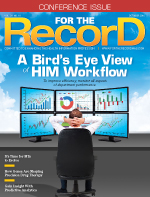October  2016
2016
Patient Profiling
By Lee DeOrio
For The Record
Vol. 28 No. 10 P. 4
The concept of mining EHR data is a wonderful thing … or is it? Thanks to EHRs, we can obtain a clearer, wider view of patient behavior. On the surface, that prospect appears to be a boon for unlocking the keys to preventive care and improved treatment protocols. But it may come at a cost.
Personally, I'm of the belief that smart people in possession of a bounty of information is a good thing, especially when it comes to health care. Nevertheless, two recent news items raised questions about how EHR data are being used.
First, an article in The Journal of the American Medical Association (JAMA) argued that EHRs that flag "frequent flyers" to the emergency department (ED) may not be ethical, particularly when it comes to behavioral health. "Seeing the high utilizer icon at the time of the patient encounter may increase the likelihood that a clinician will possibly fail to recognize medical problems. The notion that the patient is a 'frequent flyer' may interfere with the assessment of legitimate somatic symptoms and may cause the clinician to withhold or delay needed tests and procedures, which could lead to serious negative outcomes," the authors wrote.
Studies have shown that there is a stigma associated with mental health conditions—even among health care professionals. But wouldn't that still be the case even if ED staff were unaware of the number of times someone had visited? Does the stigma grow based on the number of ED visits? It may be entirely possible that identifying frequent flyers is a beneficial tool that can result in a change of course, whether a different recommendation or a new treatment.
On the heels of the JAMA study came news that insurance powerhouse Humana has been applying behavioral analytics to help guide its business approach. According to a MedCity News report, CEO Bruce Broussard told an audience at the Mayo Transform 2016 conference that for the past two years Humana has been using data to assign patients to one of 15 different personality types, including control seeker and health nut. This practice opens itself up to numerous questions, including what is the criteria for each category, and isn't it possible to be a control-seeking health nut. In any event, Humana wants to use the information to "figure out how we can help people in their needs," Broussard told attendees.
Without further clarification, Humana's approach seems random, and skeptics are sure to question the company's motives.
These are two examples, one detrimental, the other helpful, of health information being mined—although it's hard to say which is which.



